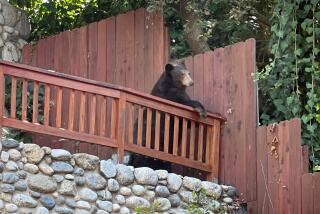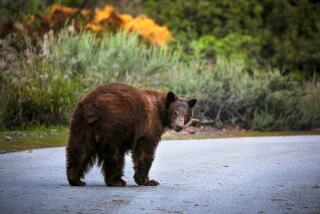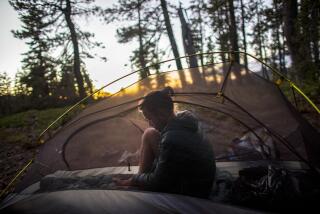Deer and Dove Seasons, Annual Rites of Autumn, Draw Thousands to the Fields
The horizon over the Chocolate Mountains was just turning pink when a muffled thunder rose from the Imperial Valley. A hailstorm of birdshot pattered down on the cars and campers parked along the grid of dirt roads.
As the morning grew brighter the source of the disturbance became visible. Great flocks of Southern Californians stood banging away with shotguns as lone doves carved frantic lines across a cloudless sky. “More hunters than birds out there,” one farmer observed, nodding toward the scrubby fields.
Dove hunting season opened across the state on Labor Day. Last Saturday was the opening day of deer season for a good part of Southern California.
On both days, people from all walks of life were out before sunrise doing things many of their urban and suburban neighbors find anachronistic if not abhorrent.
The hunters--mostly adult males and boys still shaping their concept of what it means to be a man--say they wouldn’t know that summer had turned to autumn if they hadn’t satisfied a primal instinct to tromp through the countryside at dawn with a gun.
Even nature lovers who roll their eyes at the Hemingway stuff, however, have an interest in understanding this rite of fall. Like it or not, backpackers, bird watchers, equestrians and mountain bicyclists will be crossing paths with hunters on public lands till deer and dove seasons close next month.
The state Department of Fish and Game estimates that there were 165,570 hunters out across the state last year during the 61 day split season--which ends Oct. 15, then runs another two weeks beginning Nov. 15.
By contrast, only about 17,300 hunters have received tags giving them a shot at killing a male deer with at least one forked antler in one of the four Southern California zones that opened last weekend.
The geography of dove hunting is uniquely simple--as long as the birds aren’t behind ‘No Trespassing” signs or on restricted land they’re open game anywhere in the rural parts of the state.
One of the hottest spots for dove hunting in Southern California, literally and figuratively, is the Imperial Valley, southeast of the Salton Sea.
On the weekend of the opener the place looks like a festive war zone.
Carl’s Jrs. extend their hours and the neon “No” flashes on Vacancy signs at motels in towns such as El Centro.
Most hunters, however, prefer the free accommodations along the dusty banks of the Imperial Water District canal system, which irrigates asparagus, cotton, barley and other crops.
28-Year Tradition
“We’ve been coming down for opening day 28 years now,” said Charlie Quinn of Imperial Beach as he sat beneath the canopy of a ragged salt cedar along one canal.
As Quinn talked, cars and trucks arriving from across Southern California rumbled along the dirt levees, their headlights illuminating tents and campers and motor homes and people sitting in the dark on lawn chairs discussing the nuances of dove hunting in the warm night air.
“New people add on. Old people die off,” Quinn said, gesturing at the group surrounding him in the light of a Coleman lantern.
“His dad was a long-time Navy buddy of mine,” he said, looking at a 25-year-old man who shared a chaise lounge with a sleeping Brittany spaniel. “Now his dad’s passed away and he’s filling in. It’s his first opener without him.”
By 4 the next morning, a lot of people were already awake, restlessly awaiting the moment, a half hour before official sunrise, when Mourning and Whitewing doves could legally be shot.
Groggy Hunters
At Gaston’s Cafe in the small farm town of Niland, groggy hunters piled in from the darkness and sat at the counter or stood beneath trophies of deer, geese, ducks, and fish, jabbering about the weather and grousing about the decline of grain crops, which attract doves.
Bill Hoeben and his 13-year-old son Andy sat in a booth eating bacon and eggs with hot cakes.
“I had him in a duck blind at 6 weeks,” Hoeben said. “
“I got my hunting license at 11,” said Andy, a rosy-cheeked blond in a camouflage T-shirt. “I killed things with BB guns before that.”
Bill Hoeben glanced at his son, then voiced an often repeated credo: “We don’t fish or hunt anything we’re not going to eat,” he said.
Hunting is supposed to hearken back to simpler times. But California’s hunting zones seem to have been created by the same erratic jig-saw that’s carving L.A.’s City Council Districts.
The state Fish and Game Commission’s hunting regulations, laid out in a free, three part, 32-page tabloid, are as convoluted as a city building code.
Despite the red tape, though, 488,770 Californians who passed a mandated hunter safety course bought a resident license last year, allowing them--within guidelines--to shoot badgers, bears, beavers, bobcats, and an ark-load array of other animals.
Only deer and dove hunting, however, really meet the criteria of true Southern California traditions, hunters say.
Scouting the Terrain
Like many of the 4,900 hunters who slapped down $10.50 for deer tags in the D-11 area, Jim Gillette, 35, of the Riverside County town of Pedley and 31-year-old Gordon Cook of Anaheim arrived in the Angeles National Forest the day before the Saturday morning opener to scout the terrain.
Gillette and Cook grew up together in Anaheim, and although their fathers taught them to hunt when they were boys, they’ve only stalked deer for a few years.
In fact, neither has shot a deer. But then, the killing is only a small part of what hunting’s about, Cook said, as the two stood warming themselves on a fire they had built beneath a pile of sculpted boulders on the crest of the San Gabriel Mountains.
“Jim doesn’t live a million miles away, but we don’t get many chances to get together anymore.” Cook said. “This is a chance to catch up on things.”
It’s also a chance to sit around and talk with other people, Cook said. Earlier that day, the two met a German tourist who had just encountered some hunters casually tossing beer cans and blasting squirrels out of the tall pines.
“He generalized and got a real negative opinion of hunters,” Gillette said. “But those weren’t hunters. They were shooters. A whole different breed.”
“When I was a kid, I shot a sparrow.” Cook said. He paused and rubbed his hands over the fire, apparently pondering that event.
The air had been flushed clean by a freak snowstorm the week before and by the Santa Ana winds wailing in from the desert.
To the north, the lights of Lancaster sparkled like a refection of the sky’s constellations. Los Angeles and the San Fernando Valley glowed dimly beyond the mountains to the southwest.
Cook took a sip of beer.
“Dad came up to me and said, ‘What are you going to do with it now?’ ” he said. “That hurt. That was a lesson.”
At 3:30 the next morning, Gillette and Cook grabbed their rifles and flashlights and bushwhacked their way down a ridgeline to a site below the Pacific Crest Trail where they had seen deer droppings and fresh tracks.
Sound of Gunfire
About the same time, hunters were rousing in campgrounds and turnouts throughout the forest, or heading up the Angeles Crest and Angeles Forest Highways from their homes in the flatlands.
Before the sun broke over the ridgelines, gunshots rumbled up from the canyons. Hunters’ bright orange vests and hats shone against the gray hillsides like pumpkins in a field.
Along the winding road east of Granite Mountain, 44-year-old David Miller, who works the graveyard shift at the Budweiser plant in Little Rock stood scanning the hills.
The gunfire of the hunters who had hiked down into the rugged canyons would drive deer up the brushy draws, he explained, pointing out the faint line of a game trail. The trick is to spot the well-camouflaged creatures. “You have to train your eye to see the flicker of an ear,” he said.
A second later Miller jabbed his high-powered rifle to his shoulder. A whole herd--barely visible to the naked eye--was magnified in his scope.
“They’re getting nervous,” Miller murmured, breathing hard as he held the deer in the crosshairs. “They hear us talking but they don’t know where we’re at.”
Abruptly Miller’s body stiffened. Then it relaxed. No bucks were traveling with the does and spotted fawns that morning. There was nothing for an honest man to shoot.
By afternoon most of the hunters had emerged from the canyons and returned to their campsites to brace themselves for another trek into the brush.
The success rate for hunters in the Angeles Forest last year was 3%.
More to Read
Sign up for Essential California
The most important California stories and recommendations in your inbox every morning.
You may occasionally receive promotional content from the Los Angeles Times.










